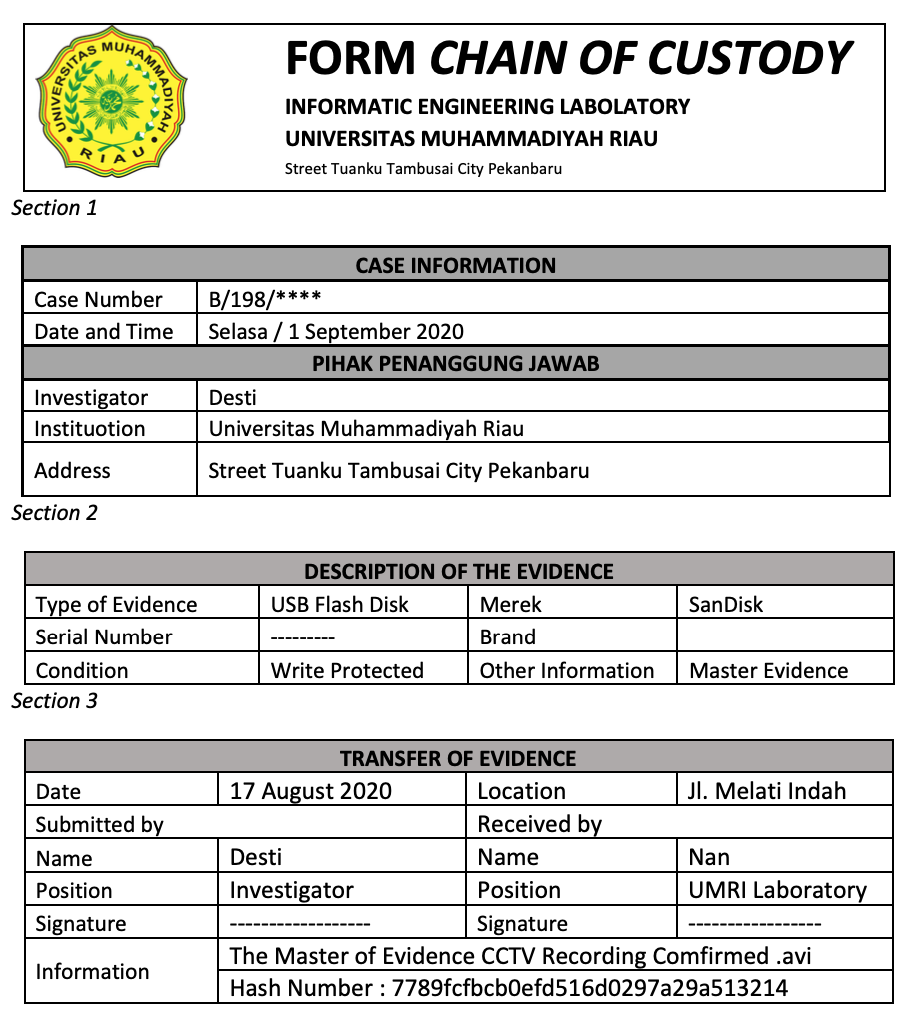Analisis Digital Forensik Rekaman Kamera CCTV Menggunakan Metode NIST (National Institute of Standards Technology)
DOI:
https://doi.org/10.25299/itjrd.2021.vol5(2).5731Keywords:
CCTV Camera, Metadata, NIST, Chain of CustodyAbstract
Conventional crimes recorded on CCTV (Closed Circuit Television) cameras are increasing, every criminal who is proven to have committed a certain crime will be punished in accordance with statutory regulations. The problem is how a case recorded on a CCTV camera can be used as digital evidence. Digital evidence is closely related to ensuring data security, privacy and integrity while following the stages of the digital forensic identification process. The identification stage using the NIST (National Institute of Standard Technolog) method is used for investigations in finding information related to metadata on CCTV camera footage so that it can provide structured information, describe and process information obtained from digital forensic investigation sources that can be implemented into the Chain of Custody document which aims to be used as legal digital evidence in court
Downloads
References
J. Hukum and K. Ummah, “Peran Laboratorium Forensik Polri Sebagai Pendukung Penyidikan Secara Ilmiah Dalam Sistem Peradilan Pidana Di Indonesia Teguh Prihmono * , Umar Ma’ruf ** , Sri Endah Wahyuningsih *** *,” J. Huk. Khaira Ummah, vol. 13, no. 1, pp. 273–286, 2018.
A. Iswardani and N. Arif, “Forensic Readiness Analysis of CCTV System in Surakarta,” Int. J. Comput. Appl., vol. 177, no. 30, pp. 36–38, 2020, doi: 10.5120/ijca2020919786.
D. Y. Sari, “Deteksi Keaslian Video Pada Handycam Dengan Metode Localization Tampering,” J. Online Inform., vol. 2, no. 1, p. 10, 2017, doi: 10.15575/join.v2i1.85.
M. N. Al Azhar, Praktical Guidlines for Computer Investigation. 2529.
E. Casey, “Interrelations between digital investigation and forensic science,” Digit. Investig., vol. 28, pp. A1–A2, 2019, doi: 10.1016/j.diin.2019.03.008.
D. Mualfah and I. Riadi, “Network Forensics For Detecting Flooding Attack On Web Server,” IJCSIS) Int. J. Comput. Sci. Inf. Secur., vol. 15, no. 2, 2017.
W. Abraham, H. Firmansyah, and W. Abraham, “Analisis Pembuktian Alat Bukti Closed Circuit Television ( CCTV ) Sebagai Alat Bukti Petunjuk,” no. 11, 2019.
M. Subli, B. Sugiantoro, and Y. Prayudi, “Metadata Forensik untuk Mendukung Proses Investigasi Digital,” J. Ilm. DASI, vol. 18, no. 1, pp. 44–50, 2017, doi: 10.13140/RG.2.2.34035.94242.
D. Mualfah, Y. Fatma, and R. A. Ramadhan, “Anti-forensics: The image asymmetry key and single layer perceptron for digital data security,” J. Phys. Conf. Ser., vol. 1517, no. 1, 2020, doi: 10.1088/1742-6596/1517/1/012106.
M. N. O. Sadiku, A. E. Shadare, and S. M. Musa, “Digital Chain of Custody,” Int. J. Adv. Res. Comput. Sci. Softw. Eng., vol. 7, no. 7, p. 117, 2017, doi: 10.23956/ijarcsse.v7i7.109.
A. Yudhana, I. Riadi, and I. Anshori, “Analisis Bukti Digital Facebook Messenger Menggunakan Metode Nist,” It J. Res. Dev., vol. 3, no. 1, pp. 13–21, 2018, doi: 10.25299/itjrd.2018.vol3(1).1658.
D. Hariyadi, F. E. Nastiti, and F. N. Aini, “Framework for Acquisition of CCTV Evidence Based on ACPO and SNI ISO / IEC 27037 : 2014,” Int. Conf. Informatics Dev., 2018.
G. Hendita, A. Kusuma, and I. N. Prawiranegara, “Analisa Digital Forensik Rekaman Video CCTV dengan Menggunakan Metadata dan Hash,” Pros. Semin. Nas. Sist. Inf. dan Teknol., vol. 3, no. 1, pp. 223–227, 2019.
W. Pranoto, I. RIadi, and Y. Prayudi, “Live forensics method for acquisition on the Solid State Drive (SSD) NVMe TRIM function,” Kinet. Game Technol. Inf. Syst. Comput. Network, Comput. Electron. Control, vol. 5, no. 2, pp. 129–138, 2020, doi: 10.22219/kinetik.v5i2.1032.
R. A. Ramadhan, Y. Prayudi, and B. Sugiantoro, “Implementasi dan Analisis Forensika Digital Pada Fitur Trim Solid State Drive (SSD),” Teknomatika, vol. 9, no. 2, pp. 1–13, 2017, [Online]. Available: http://teknomatika.stmikayani.ac.id/wp-content/uploads/2017/07/1.pdf.
R. Alshalawi and T. Alghamdi, “Forensic tool for wireless surveillance camera,” Int. Conf. Adv. Commun. Technol. ICACT, no. January 2017, pp. 536–540, 2017, doi: 10.23919/ICACT.2017.7890148.
J. L. J. Carter and M. M. N. M. Wegman, “Classes of Hash Functions,” J. Comput. Syst. Sci., pp. 143–154, 1979, [Online]. Available: http://www.sciencedirect.com/science/article/pii/0022000079900448.
X. Du, N. A. Le-Khac, and M. Scanlon, “Evaluation of digital forensic process models with respect to digital forensics as a service,” Eur. Conf. Inf. Warf. Secur. ECCWS, pp. 573–581, 2017.
G. Wicaksono and Y. Prayudi, “Teknik Forensika Audio Untuk Analisa Suara Pada Barang Bukti Digital,” Semnas Unjani, 2013.
A. Putra Justicia, “Analysis of Forensic Video in Storage Data Using Tampering Method,” Int. J. Cyber-Security Digit. Forensics, vol. 7, no. 3, pp. 328–335, 2018, doi: 10.17781/p002471.
G. Giova, “Improving Chain of Custody in Forensic Investigation of Electronic Digital Systems,” Int. J. Comput. Sci. Netw. Secur., vol. 11, no. 1, pp. 1–9, 2011.
Shahraki, A. S., Sayyadi, H., & Amri, M. H. (2013). Survey: Video Forensic Tools, 47(1), 98–107.
Satti, R. S., & Jafari, F. (2015). Domain Specific Cyber Forensic Investigation Process Model. Journal of Advances in Computer Networks, 3(1), 75–81. https://doi.org/10.7763/JACN.2015.V3.145.
Y. Prayudi, “Problema dan Solusi Digital Chain Of Custody dalam Proses Investigasi Cybercrime,” 2014.

Downloads
Published
How to Cite
Issue
Section
License
This is an open access journal which means that all content is freely available without charge to the user or his/her institution. The copyright in the text of individual articles (including research articles, opinion articles, and abstracts) is the property of their respective authors, subject to a Creative Commons CC-BY-SA licence granted to all others. ITJRD allows the author(s) to hold the copyright without restrictions and allows the author to retain publishing rights without restrictions.















